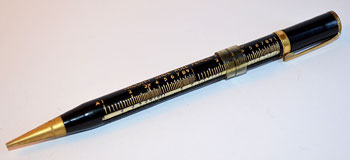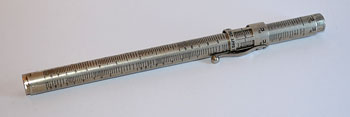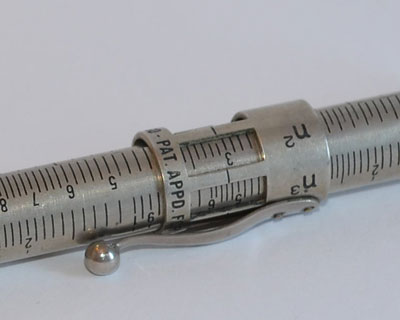 |
|
|
|

|

|
Three “pencil” slide rules |
|
|
|
|
20th century Engineers just loved pens and
pencils (hence the pocket protector, that iconic geek accessory of
yesteryear). And of course, engineers lived by their slide rules.
Small wonder, then, that enterprising inventors tried to pack the
functionality of the slide rule into a pencil form factor – a thin
rod you could clip into your shirt pocket. And if it could actually
write, so much the better! I have three devices with this form factor in my collection, and two of them actually have pencil functionality in addition to calculating. Here they are: |
|
|
|
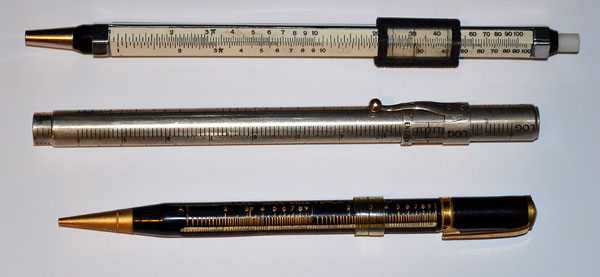 Click photo to enlarge |
|
|
|
cutout on the outer tube, which is flanked by those A and D
scales. You rotate the cap to choose which scale shows through, and
pull it to move the inner scale relative to the outer two. Add the
clear annular hairline cursor that slides along the pen and you have
a tubular implementation of a regular slide rule, capable of
multiplying, dividing, and handling reciprocals, squares and cubes. This slide rule is described in a patent applied for in 1953 by Nicholas E. Nicolet and Herman Neiges, of New York. Despite the praises in that document, it has a limited accuracy due to its very short (3 inch) scales and poor dimensional stability: the scales on my exemplar are visibly warped. The photo below shows how the C and D scales are set to perform multiplication by 2. |
|
|
|
 Click photo to enlarge |
|
|
|
The second device has a very different design. This is the Makeba Kombinator, manufactured in Bautzen, Eastern Germany, in the 50’s or 60’s. |
|
|
|
 Click photo to enlarge |
|
|
|
The third device in this article is the most unusual – and is very rare; so much so that I’ve never seen or read about another one. This is the EngPen, made in Chicago by the EngPen company, of which I have no information whatsoever. An inscription on the cursor states that a patent has been applied for – but I haven’t found that either. My fellow collector Rodger Shepherd called my attention to a patent (uncovered by Panagiotis Venetsianos) granted in 1908 for a rather similar device invented by one William S. Harlow of Massachusetts. |
|
|
|
 Click photo to enlarge |
|
|
|
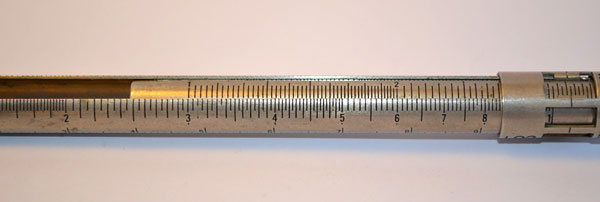 Click photo to enlarge |
|
|
|
There were a number of other models of pencil
slide rules in those days, which raises the question: what made them
worth producing? Sure, their owners would be certain never to be caught
without a calculator, but in reality anyone competent to use a slide
rule – an engineer, or a scientist – would use a larger rule, 12
inch long at least, which would have far greater precision. And even
if one wanted a pocket-sized model, a straight six-inch slip stick
is far easier to use than these combination models, which must
inevitably embody a design compromise. But then, perhaps these nifty gadgets were intended for use as novelties... they sure would make excellent father’s day gifts for the engineer who has it all!... |
|
|
|
Exhibit provenance: eBay, from three different sellers. |
|
|
|
|
|
|
|
Home | HOC | Fractals | Miscellany | About | Contact Copyright © 2014 N. Zeldes. All rights reserved. |
|
